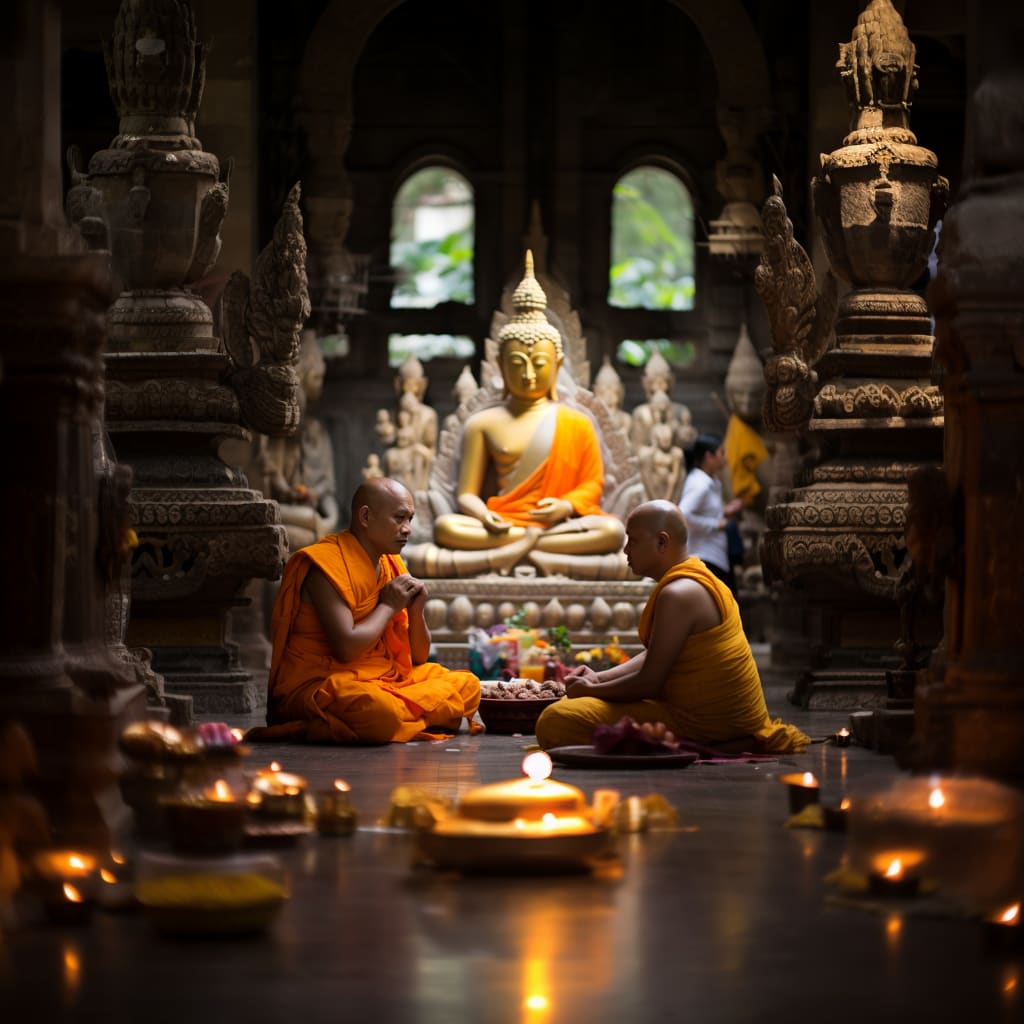The Confluence of Cultures: Exploring the Influence of Indian Hinduism on Thai Buddhism
A Historical and Cultural Journey into the Syncretic Nature of Thai Buddhism

Introduction
I have previously visited Thailand six times and developed a keen interest in the stark differences between Thai Buddhism and Chinese Buddhism. This curiosity led me to contemplate the notion that Thai Buddhism may be a delayed extension of Hinduism. It prompted me to embark on an exploration of the influence of Indian Hinduism on Thai religion.
The influence of Indian culture, particularly Hinduism, on Thai Buddhism is a topic of immense historical and cultural significance. This topic holds historical and cultural significance as it showcases the interplay and exchange between two vibrant religious and cultural traditions. It not only sheds light on the historical connections between India and Thailand but also provides insights into the contemporary Thai society and culture. Thai Buddhism, with its incorporation of Indian Hindu elements, has contributed to Thailand's cultural diversity, inclusivity, and identity, making it a remarkable example of religious syncretism.
The Indian Connection
The process of Indianization, through which Indian culture spread to Southeast Asia, unfolded during a specific historical timeframe. Between the 1st and 6th centuries CE, there was an intensive exchange of Indian religious, political, and artistic ideas with Southeast Asia, including Thailand. This period witnessed the transmission of various aspects of Indian culture, such as religion, language, literature, philosophy, and art, to the region. For example, ancient trade routes facilitated the exchange of goods, ideas, and beliefs, resulting in the assimilation of Indian cultural elements into the local customs and traditions.
The Spread of Buddhism
While it is widely believed that Buddhism was introduced to Thailand around the 3rd century BCE, the exact timeframe and sources may require further research and archaeological evidence. Nevertheless, the impact of Buddhism on Thai society and culture cannot be overstated. The introduction of Buddhism brought about significant changes in Thai society, influencing its political systems, legal frameworks, educational institutions, artistic expressions, and moral values. Buddhism became deeply ingrained in the fabric of Thai society, permeating various aspects of life, from personal beliefs and rituals to governance and social structures.
One example of Buddhism's impact on Thai society is its influence on Thai politics. The concept of a "righteous king" emerged, highlighting the ideal of a just ruler who upholds Buddhist principles and governs with compassion and wisdom. This notion influenced the development of Thai political systems and the establishment of a monarchy that embraced Buddhist values.
Buddhism also played a vital role in shaping Thai law and justice. The teachings of Buddhism, emphasizing moral conduct, fairness, and the pursuit of enlightenment, influenced the development of legal codes and the administration of justice in Thailand. Even today, Buddhist principles continue to influence Thai legal frameworks and serve as a moral compass for the judiciary.
In the field of education, Buddhism has been instrumental in shaping Thai educational systems. Monastic education, provided in Buddhist temples, has played a significant role in imparting knowledge, instilling moral values, and nurturing a sense of community among the Thai population. Buddhist temples have traditionally served as centers of learning and provided education not only in religious matters but also in various secular subjects, including language, literature, history, and art.
Furthermore, Buddhism has had a profound impact on Thai art and architecture. Thai Buddhist temples, known as "wats," are not only places of worship but also cultural and artistic masterpieces. The design and construction of Thai temples reflect the integration of Buddhist principles, Hindu influences, and local architectural styles. Elaborate temple structures, intricate sculptures, vibrant murals, and exquisite craftsmanship are testaments to the fusion of Indian and indigenous artistic traditions within Thai Buddhism.
The Influence of Hinduism on Thai Buddhism
Thai Buddhism beautifully integrates various elements of Indian Hindu mythology and deities, enriching its religious landscape. The revered characters of the Ramayana, such as Rama and Hanuman, find their expressions in Thai Buddhist traditions and art. The Thai version of the Ramayana, known as the Ramakien, holds a central place in Thai literature, dance, and theater. It is not only an epic tale but also a cultural treasure that resonates with the Thai people, showcasing the enduring influence of Indian Hindu mythologyand its integration into Thai Buddhist culture.
In addition to the Ramakien, Hindu deities hold significant positions within Thai Buddhism and are often worshipped in Thai Buddhist temples. Brahma, the creator deity, is commonly depicted in Thai temples, particularly in the famous Erawan Shrine in Bangkok. Indra, the king of gods, is revered as the guardian deity of Thai kingship and is believed to protect the country. Ganesha, the elephant-headed deity, is revered as the remover of obstacles and is worshipped by devotees seeking success and prosperity.
The representation of these deities in Thai Buddhist temples goes beyond their mere presence. They are intricately woven into the fabric of Thai religious practices and rituals. For example, during important Buddhist festivals, Hindu deities are paraded through the streets, accompanied by traditional music and dance performances. Devotees pay homage to these deities, seeking their blessings and protection. The fusion of Hindu and Buddhist elements in these celebrations showcases the harmonious coexistence of both religious traditions in Thai society.
Moreover, the symbolism associated with Hindu deities within Thai Buddhism reflects the interplay of various cultural beliefs. Brahma, representing creation, symbolizes the transformative power of the mind and the ability to cultivate positive qualities. Indra, associated with kingship, represents leadership, protection, and prosperity. Ganesha, known as the remover of obstacles, symbolizes overcoming challenges and achieving success. These deities serve as spiritual guides and sources of inspiration for Thai Buddhists, embodying values and aspirations that resonate with the Thai people.
The Syncretic Nature of Thai Buddhism
Thai Buddhism exemplifies its syncretic nature by harmoniously incorporating elements from different religious traditions. Besides Indian Hinduism, Thai Buddhism also integrates indigenous animism and Mahayana Buddhism, resulting in a diverse religious tapestry. The integration of these different traditions is evident in various aspects of Thai Buddhist theory, practice, rituals, and moral principles.
For instance, the concept of karma, the law of cause and effect, is central to both Hinduism and Buddhism. In Thai Buddhism, the understanding of karma extends beyond individual actions to encompass societal and cosmic implications. The belief in karma influences Thai moral values, emphasizing personal responsibility, ethical conduct, and the cultivation of wholesome actions.
The belief in reincarnation, another shared concept between Hinduism and Buddhism, is also deeply ingrained in Thai Buddhist beliefs. The cycle of birth, death, and rebirth is seen as a continuous journey towards spiritual liberation. Thai Buddhists aspire to break free from the cycle of rebirth through the pursuit of enlightenment and the cessation of suffering.
Thai Buddhism also draws from indigenous animistic beliefs, which venerate spirits and natural forces. This amalgamation of beliefs is evident in Thai rituals and ceremonies, where offerings and prayers are made to both Buddhist deities and local spirits. It reflects the interconnectedness of nature and spirituality in Thai culture, acknowledging the presence of unseen beings and the importance of maintaining harmony with the natural world.
Conclusion
The enduring influence of Indian Hinduism on Thai Buddhism serves as a testament to the deep historical and cultural connections between India and Thailand. This influence continues to shape and evolve Thai Buddhism, fostering cultural exchange and religious syncretism. The ongoing dynamics between Hinduism and Thai Buddhism present avenues for further research, exploring the interactions, conflicts, and coexistence of these religious traditions within Thai society.
The influence of Hinduism on Thai Buddhism raises intriguing questions about the continued relevance and adaptation of these traditions in contemporary Thailand. It prompts us to inquire whether Hindu influences are still prevalent and evolving in Thai Buddhist practices, and how they intersect with modern interpretations of Buddhism. Furthermore, an exploration of the role and significance of Hinduism and Thai Buddhism in contemporary Thai society sheds light on the multifaceted religious landscape and its impacton various aspects of Thai culture, including social norms, values, and identity.
Additionally, investigating the interaction between Hinduism and Thai Buddhism can provide insights into the dynamics of religious pluralism and coexistence in Thailand. Are there instances of syncretism or tension between the two religious traditions? How do adherents of Hinduism and Thai Buddhism navigate their religious practices and beliefs in a society characterized by cultural diversity?
Understanding the contemporary status and role of Hinduism and Thai Buddhism in Thailand contributes to a broader understanding of the country's religious landscape and its significance in shaping individual and collective identities. It allows for a nuanced exploration of the ongoing religious, cultural, and social transformations in Thailand, emphasizing the importance of recognizing and appreciating the interplay between different religious traditions in a rapidly changing world.
In conclusion, the influence of Indian Hinduism on Thai Buddhism transcends historical and cultural boundaries, leaving an indelible mark on Thai society. The historical and cultural connections between India and Thailand, as exemplified through the interaction of these two religious traditions, continue to shape Thai Buddhism. By exploring this fascinating topic, we gain a deeper appreciation for the richness of religious syncretism, the adaptability of cultural exchanges, and the profound impact of interreligious influences in shaping the vibrant tapestry of Thai culture and spirituality.
About the Creator
Huatin OU
Originally from Western China,live in Saskatoon as a freelance writer. vibrant energy of this city fuels creativity, lending a unique flair to work. a fusion of Eastern roots and Western experiences, captures the magic find in everyday life
Enjoyed the story? Support the Creator.
Subscribe for free to receive all their stories in your feed. You could also pledge your support or give them a one-off tip, letting them know you appreciate their work.






Comments
There are no comments for this story
Be the first to respond and start the conversation.